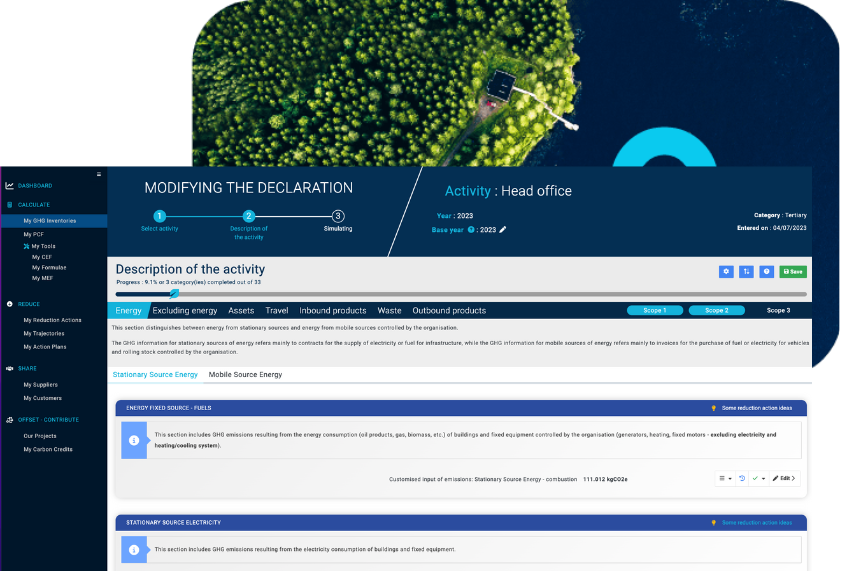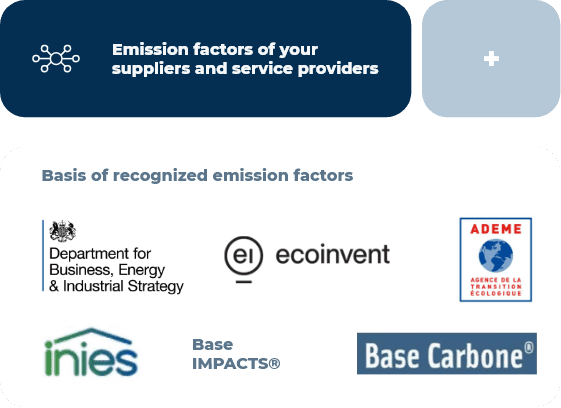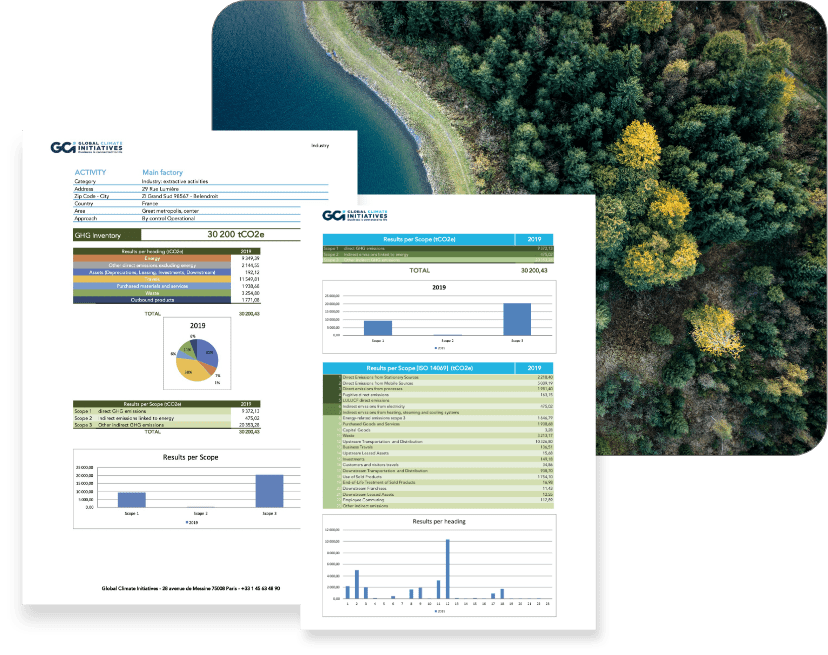Calculate and improve your company's Carbon inventory
GCI can be tailored to your specific industry, prioritise the most emitting headings, and define the main reduction avenues for your company.

Precise measure of your carbon footprint.
Complete, compliant GHG balance sheet covering all 3 scopes.
Tailored to your company or organisation's sector.
Identify priority reduction avenues.

Why carry out your GHG assessment on the GCI platform?
Our 12 years of experience and thousands of users guarantee you the most complete and educational service, and access to the world's richest database of emission factors, including those of your suppliers.
- 100% online tool.
- The market's most precise GHG emissions calculator.
- Carry out your GHG inventory independently or supported by a GCI carbon expert.
- Commented annual report enables explanation and confirmation of your low carbon strategy to all your stakeholders
How to contact
a GCI expert?
GCI offers you its network of experts to help you with your company's decarbonization strategy. You can then choose the one that best suits your needs in terms of location, expertise and sector of activity.
It's possible to contact an expert directly by email from the GCI expert gallery.
You can also contact us, and we will suggest the Certified Expert who will best suit your needs.
A methodology tailored to the needs of your company
Scope 1
Sources of direct fixed or mobile emissions from combustion engines industrial processes, leaks of refrigeration gases or biomass.
Scope 2
Sources of indirect emissions from the production of electricity, heat, steam or cold imported for the organization's activities.
Scope 3
Sources of indirect emissions associated with the purchase of goods and services, employee and customer travel, use and end-of-life of products sold, and waste.
Data collection
Be guided by our ergonomic interface and easily carry out a GHG inventory tailored to your organisation and your activity sector quite independently.
Questionnaires which are specific and tailored to your company's sector.
Online help, tutorials, FAQ and a GCI expert to support you in your enquiries.
Choose and develop your level of analysis.
Multi-user, Multilingual, centralization and supervision of data.


Accurate and compliant calculation
(ISO 14067) of your emission factors and those of your suppliers
Measure your own GHG emission factors precisely and consistently, and obtain those of your suppliers, thanks to our open, collaborative carbon footprinting platform, suitable for all types of organization.
Automatic classification of each calculation of emission heading to Scope 1, 2 or 3.
Choice of emission factors open to all the reference databases (Base Carbone, Impacts, Ecoinvent, Inies, Beis-Defra etc_ and those of your suppliers.
ONLY at GCI: You can invite your suppliers to calculate the emission factors of the goods and services they offer you, free of charge, in full compliance with ISO 14067.
A full, compliant and forward looking GHG inventory
The calculation methodology and the emission factors used are totally in conformity to regulations and the recognised references: Bilan Carbone method, ISO 14064, ISO 14067, GHG Protocol.
Analytical report with hierarchy, detail and precision
Reduction avenues for each emission heading
Specific formatting for uploading to the dedicated ADEME site

DEVELOP AND MAINTAIN YOUR
COMPANY WITH THE
GCI PLATFORM
Our difference, your strength
The calculator adapts to your organisation

Industrial and commercial sites
The GCI platform allows industrial and commercial sites the complete and compliant calculation of all their emissions, including supply, process, storage, preparation, transport and marketing.

Tertiary and service companies
Organizations are identifying solutions that allow them to develop their activities in a sustainable manner by focusing their efforts on reducing their GHG emissions.

Haulage
The GCI platform offers a calculator of GHG emissions from transport, the main objective of which is to reduce their environmental impact.

Events
GCI helps organizations minimize their negative impacts on the environment and have a beneficial impact for the host community and all stakeholders.
The next stage
01
Calculate your
GHG inventory

Download our guides
and resources
More information on the Carbon Footprint®.
How does CSRD redefine companies' low-carbon strategies?
New European directives, such as the CSRD and SFDR, are redefining the rules of the game, imposing strict obligations on companies and investors to reassess their practices and business models.
Reducing the carbon impact of purchasing: Lifecycle Analysis as a strategic tool under ISO 14067
The ISO 14067 standard helps companies to measure and reduce the carbon footprint of their products, by optimizing the supply chain. GCI supports this approach with Décarbon'Achats® for a sustainable transition.
Mistakes to avoid for an accurate carbon footprint and an effective reduction strategy
Bilan Carbone® is essential for reducing GHG emissions, but errors or outdated data can limit its effectiveness. Involving all stakeholders and setting clear objectives are key to success.
We answer your questions!
How do I calculate my company's carbon inventory?
First of all, carrying out a greenhouse gas assessment, also known as a carbon footprint, enables a company to accurately assess its carbon footprint and understand the main source of each of its greenhouse gas emissions.
The main difference between the Bilan Carbone and the Bilan GES lies in the definition of the emissions accounting perimeter.
In the Ademe methodology, the GHG inventory® calculation takes into account the entire life cycle of a company's products or services. This enables a global assessment of the company's GHG emissions, and the identification of any sources of savings.
Greenhouse gas (GHG) emissions are assessed on the basis of consumption, using conversion factors specific to each energy source. This makes it possible to standardize measurements and obtain a quantity of emissions expressed in carbon dioxide equivalent (CO2e).
In other words, it's a simple matter of multiplying your activity data (in kWh, units, liters, €) by an emission factor (average quantity of greenhouse gas emissions for 1 unit of your activity data).
To calculate your GHG footprint, all you need to do is make an inventory of all your activities that directly and indirectly emit greenhouse gases, and convert them using an emission factor.
Why carry out my carbon inventory?
Apart from regulatory obligations (especially since the decree n°2022-982), carrying out a carbon inventory is an essential step for a company because it makes it possible to identify and list the greenhouse gas emission headings directly or indirectly linked to its activity.
Carrying out your first carbon inventory will enable initial measurement and detection of the main emission headings. This will make it easier to identify potential reduction opportunities and define a low-carbon strategy for your company.
Carrying out regular Carbon Inventories over time will be an opportunity to adjust your action plan and to ensure that your objectives for reducing the environmental impact of your business are met.
What data do I need to provide?
For an accurate measurement of greenhouse gas emissions, it is necessary to identify all of the emission headings of the company. This means it is necessary to carry out an inventory of its activity data:
- Energy consumption (gas, oil, diesel, petrol, electricity, etc. .....)
- Depreciating assets (real estate, fleet of vehicles, computer equipment, furniture, etc.)
- Purchases of goods (raw materials, materials, food, etc.)
- Purchases of services (internet contract, maintenance and installation of equipment, supplies of services, fees, etc....)
- Movement of people: employee commuting, business travel, visitors and customers, etc. .....
- Haulage
- Disposal
- Use and end of life of products sold.
Although it is recommended to be as exhaustive as possible in identifying emission headings, it is possible to start with financial data and to refine the accuracy of the data over time. We recommend that you carry out your inventory in stages, starting with your largest expenditure items first.
How can I reduce my company's carbon footprint?
Reducing the carbon footprint of your company is a multi-step process:
- Carry out an initial assessment of your carbon footprint.
- Identify the most important emission headings, and find ways to reduce them by improving the accuracy of the data used for measurement.
- Involve your suppliers by asking them to calculate the carbon footprint of the goods and services they supply. The measurement will be all the more accurate and you will then be able to implement a responsible purchasing strategy.
- Set up an action plan and a measurement strategy over time to ensure that it is implemented and effective.



